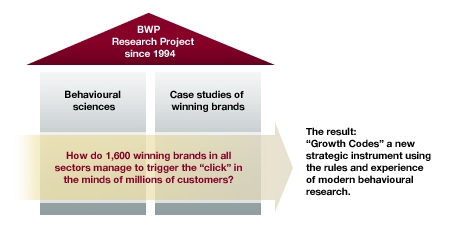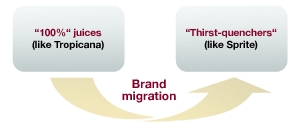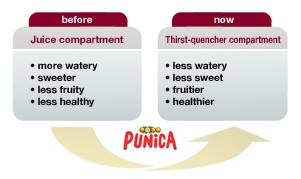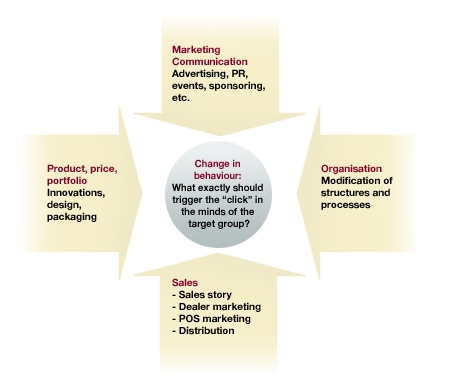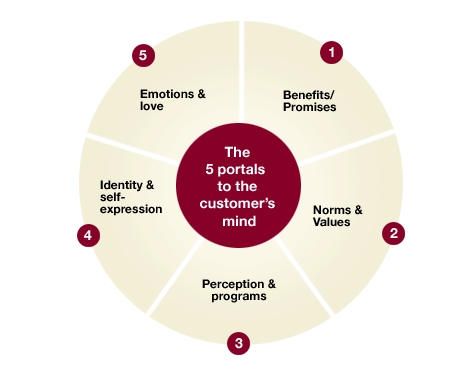

The premises: growth (in your company’s favour) invariably requires a change of behaviour in the target groups. Economists assume that customers and consumers aim for the “maximisation of benefit”, with the result that only unique benefit propositions relating to quality, service or benefit (factual or emotional) can effect a behavioural change in your favour.
Behavioural scientists think very differently from economists in this respect: over many decades, they have researched a wide spectrum of factors, principles, regulations and mechanisms which make up human behaviour and behavioural changes. Their fascinating findings and concepts are used for example by star attorneys to win the support of judge and jury. And by politicians fighting their election campaigns on the world’s great stages.
Over the last fifteen years, Buchholz Wördemann Partner has evaluated this wealth of empirical knowledge and used it to develop a strategic instrument with which companies can systematically examine the possibilities open to them of influencing the behaviour of their target groups (e.g. customers, dealers, opinion leaders) and thus of implementing a sustainable change of course in the face of the competition.
What exactly is behind this approach?
![]()
|
Since 1994, BWP’s international winning brand research project has been consistently investigating the success of winning brands in various segments using the wealth of findings and concepts identified by the behavioural sciences. 1,600 winning brands have been analysed for this purpose, including product, service, trade and corporate brands in the Business-to-Consumer and Business-to-Business sectors. Winning brands are defined as brands which in relation to their market environment book growths in sales or turnover well above the average over several years – without necessarily having “factual”, “hard” or “technical” product advantages over the competition. The focus is therefore on brands which have succeeded in making the famous “click” through their added value in the customers’ minds.
|
||||||||||||||||
|
How can an individual company use the findings of the behavioural sciences and the experience of winning brands to increase their own growth? – And what exactly is this new “growth code” instrument? We have taken an example from the consumer goods industry for purposes of simplification: Let us also assume that you are neither able nor willing to change anything about the product quality itself, and that you do not want to reduce the price. How can you still influence customer behaviour purposefully and strategically in order to promote new growth in double figures sustainable over a longer period of time? This is where the strategic mechanisms of behavioural changes come into play. We call them “growth codes”. In our terminology, one of these (from a total of more than 120) is called “the Migration Principle”. The Migration principle: “Position your brand in a different, unexpected mental compartment in which it will be better able to develop its strengths.” Now we see the core problem in a new light: our fruit juice drink is in the “wrong” mental compartment, i.e. with the “100% juices”, where it has to stand up to comparison with premium juices and will inevitably come off worse. However, with its “watery” characteristics, we could also move our beverage brand to another mental compartment, i.e. to the thirst quenchers and soft drinks, where it will be compared with completely different products, i.e. lemonades like Sprite.
So if we now consistently position our fruit juice drink purely as a better alternative to other thirst quenchers/soft drinks/lemonades, something astonishing happens in the customers’ minds: all attributes previously perceived as negative suddenly become positive! This is because our product is suddenly less watery, less sweet but fruitier and healthier than lemonades.
As a high-quality alternative to lemonade, our fruit juice drink Punica (by Procter&Gamble) booked a growth rate of 35% per annum during the first years. Without changing anything about the product, and without reducing the price. What exactly does the growth code “Migration principle” consist of? To this are added several success factors which ensure that the growth code is applied correctly and that all potential is exploited to the maximum. Here are the three success factors of the “Migration principle”: 1. Acceptance 2. Market potential 3. Unique selling proposition As all success factors are met, you can now be relatively certain that your behaviour-changing strategy will be successful. How does the new concept affect all areas of marketing and sales?
And what was the new course for Punica? 1. In the brand communication area: Punica developed the “Punica oasis” as a selling idea and key visual. 2. In the product, price, assortment, innovation areas: Punica placed new emphasis on innovation. Instead of new flavours (as with juices), they suddenly introduced “Tea&Fruit” variations. Today people think of carbonated Punica thirst quenchers. 3. In the trade and distribution areas: Punica was removed from the “juices“ shelf and positioned near the lemonades. Multi-packs/crates were marketed rather than single bottles. 4. In the organisational, structural and process areas. Changes in these areas were not relevant for Punica. Setting a new course does not mean performing all marketing and sales activities differently. Rather the aim is to change the course in such a way that everything is focused on the “click in the mind” which precedes a change in behaviour. |
||||||||||||||||
|
You have now become acquainted with just one growth code: the “category principle”. Now imagine you had a strategic “toolbox” at your disposal containing more than 120 completely different instruments enabling you to influence the behaviour of widely varying target groups in vastly differing competitive situations. This gives you the chance to fan out the wide range of opportunities practically to its full extent. Here is an overview of some of the most important “growth codes”:
We are often asked how to go about finding the most appropriate or powerful “growth code” for tackling a specific challenge on the market. In accordance with the modern behavioural sciences, we have classified the growth codes under “5 portals to the customer’s mind”. In a sense, these are the five different compartments in our toolbox.
The vast majority of companies use the possibilities from portal 1, “Benefits and Promises”, most of all: for decades, marketing has focused above all on the unique “benefit” or “USP” – as if this were the only way to influence customer behaviour. |
||||||||||||||||
|
The way in which people make decisions relating to their actions is invariably the same, regardless of whether they are buying a thirst-quencher (as a private person), making a business investment decision (e.g. deciding on a new leasing partner) or deciding on a certain insulin therapy (as a doctor). This is why we use our behavioural change approach to tackle challenges in a very wide variety of sectors. Examples:
|
||||||||||||||||
The BWP research project (since 1994)
.............................................................................
The new “growth code” instrument
.............................................................................
An overview of our strategic “toolbox”
.............................................................................
Why this approach is universally applicable







